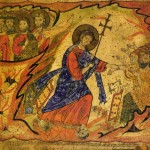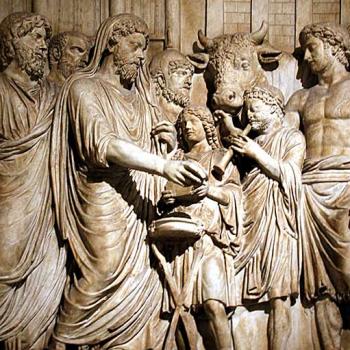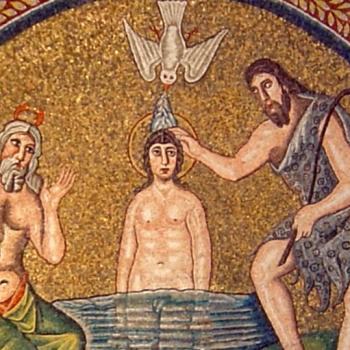As we remember the Crucifixion today, it’s important to also remember the extraordinary tradition of our Christian faith, and the centrality of Christ’s death and resurrection to Christians throughout history.
We can glimpse a bit of the historical importance of the crucifixion through early Christian depictions of that event. The absolute earliest visual depictions of Jesus’s crucifixion exist in the form of a symbol called the staurogram.
This is a staurogram:
The symbol was used by early New Testament scribes when writing about Christ’s death: within the text itself, they substituted the staurogram in place of the words “cross” and “crucifixion.”
The monogram comprises two letters from the Greek word stauros, meaning “cross.” In Greek that word looks like this:
You take from that word the letter T (that is, the tau), and the letter P (the rho), combine them, and you have the staurogram—which is also a pictogram of a person on a cross. Brilliant, no?
Though the tau-rho symbol was used as an abbreviation prior to Christianity, Christian scribes appropriated it for their own needs and imbued it with theological significance, using it in late 2nd- and early 3rd-century New Testament manuscripts such as P45, P66, and P75.
You can see the staurogram in this image of John 19:15-20, from the manuscript P66. I’ve highlighted the three spots on this page of the manuscript—much of which, as you can see, is missing—where it appears (however indistinctly) in verses 16, 18 and 19 (19 has a piece missing from the middle of the symbol).
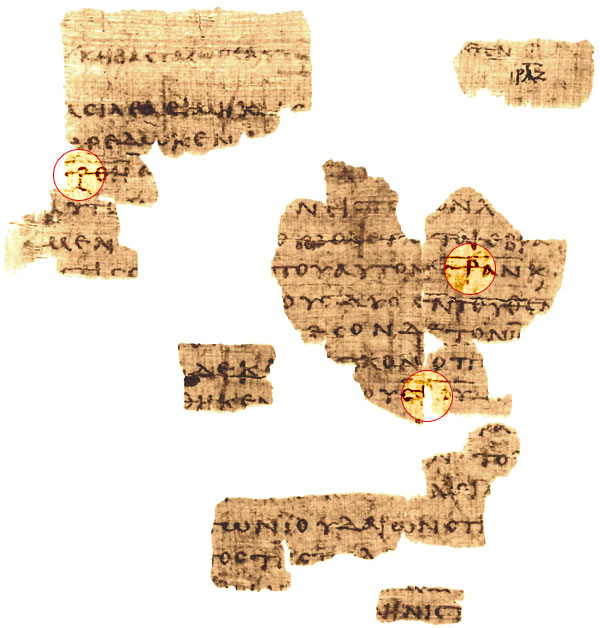
Here’s the corresponding English text with the staurogram substituted where it appears in the original manuscript:
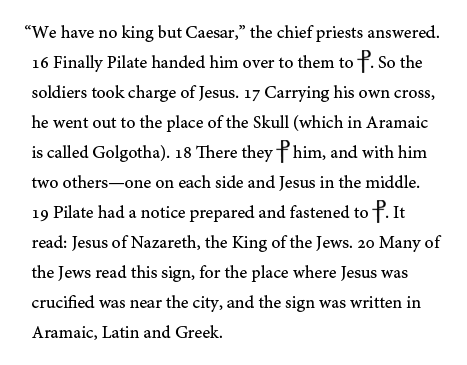
This tiny symbol, embedded within the text of ancient and fragmentary documents, lets us share the reverence and respect that early Christians had for Christ’s death. In the staurogram we see not only the first depiction of Christ on the cross, but also the beginning of Christian art and iconography.
Good Friday is a time of deep reflection. As we feel and think about what happened that day on the hill called Calvary, let us at times recall that we are not alone, but rather part of a great tradition that has reflected upon and responded to the crucifixion of Jesus Christ for nearly two thousand years.
Further reading:
Larry W. Hurtado, The Earliest Christian Artifacts: Manuscripts and Christian Origins (Eerdmans, 2006), 135-54
Larry W. Hurtado, “The Staurogram in Early Christian Manuscripts: The Earliest Visual Reference to the Crucified Jesus?,” in New Testament Manuscripts: Their Text and Their World, ed. Thomas J. Kraus and Tobias Nicklas. “Texts and Editions for New Testament Study,” 2. Leiden: Brill 2006. Pp. 207-26.
Thank you to John Shore for his help with this piece.
 Dan Wilkinson
Dan Wilkinson
Dan is the Executive Editor of the Unfundamentalist Christians blog. He is a writer, graphic designer and IT specialist. He lives in Montana, is married and owns three cats.



